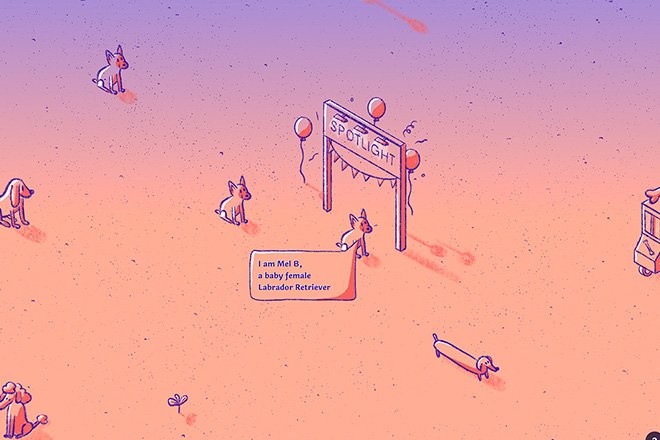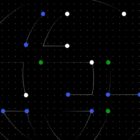
If you are looking for a design trend that can hold up over time, consider using a gradient. Every time I seem to think this trend might be over, designers come up with new and even better ways to use color variations for immense impact.
I’m not sure this trend will ever get old because there are so many ways to use it.
Here, we’re going to look at 10 different ways to make the most of gradients with projects that do it exceptionally well. All completely varied, and all completely unique!
Call to Action Gradients
Use a gradient with a minimal design or when there’s not a lot of other color to draw users to the main button or call to action in the design.
The pulsing, color-changing gradient in the design above steals your attention and makes you want to click to see what happens. Without a lot of other content or encouragement, the gradient helps provide all the information you need to get deeper into the design.
And the color choices are quite nice as well.
Gradients and Photo Overlays
Gradients can make the perfect photo overlay to help tone down an image for other elements or add extra visual interest to an image that has less-than-ideal color.
A gradient overlay can help add your brand to imagery or website design with a stronger connection to your color palette. This can be a popular option with brands that have strong color associations.
In the example above from USA Volleyball, the gradient does two things. The lighter part of the gradient helps the “action” part of the image stand out while fading less important background elements of the photo. It also helps tie the USA red, white, and blue theme to the overall website design in a subtle, but effective way.
Text Gradients
Text and gradients aren’t things that you would expect to go together but they can have a fabulous marriage.
It takes a few of things for text and gradients to work well together:
- Text gradient as a focal point that doesn’t compete with other high-color elements
- Use in a small space, such as one word or a short phrase
- Plenty of contrast with surrounding elements
- Highly readable words, fonts, or color choices
The trick to making a text gradient work is ensuring that it remains readable.
Gradients and Illustrations
Gradients can be a digital illustrator’s super power.
Here’s why: Color change help create depth and direction. They can add interest to a two-dimension design or take something simple and make it feel a little more complex. But not overwhelming.
The full-screen illustration above is a perfect example. Imagine the design with the background gradient stripped away. Even with the purple sketch design for the drawings, it would feel a little flat. The gradient is that something extra that takes it to the next level.
Radial Gradients
Radial gradients are a lesser used option but can be great for adding a point of focus for design elements.
Note how the lighter location on the screen helps bring you to the bouncing elements above. Just like with other gradient uses, the color choice helps create depth to make the foreground elements seem to lift off the screen just a bit.
Primarily, radial gradients work best with a single color because they can get heavy on the eyes quickly. Radial fades also have an innate symmetry that might not work with every design, so think about what you want the gradient to do when considering this option.
Gradient Backgrounds
A background gradient is probably the most popular use of this color trend.
It works with bold choices, bright colors, muted palettes, or almost any other combination you can come up with. Gradients might include variations between two or more hues.
The real trick to making it work is using color choices that set the right tone and include enough contrast so that other elements in the design show well.
If you click through the example above, there’s an extra background hover gradient that follows your mouse to add extra saturation of color behind text elements to enhance readability and call to action instruction. (It’s a rather nice touch.)
Monotone Gradients
The classic monotone gradient is one of those things that gets better with time. Designers are creating deeper color variations with more pixel-perfect designs for elements that look flawless.
Monotone gradients can also help emphasize brand color palettes, serve as the foundation for an image or illustration (such as the example above), or as a background element.
Monotone gradients work equally well with strong contrast in a single hue or a minimal amount of variation, which is more effective for establishing depth.
Gradients with Trendy Colors
If you are intimidated by using a trendy new color, but want to try it in a design a gradient can help. Use a trendy color choice with something from your palette to maintain brand identity with a modern feel.
The example above uses multiple gradients in different layers to help you move through the design. Note how your eyes may see the big background gradient first, but then you start to note more color variations and options from the bright colors in the boxes to the inside white gradient edges on the shape frames.
A good set of gradient layers can help you work with trendy colors in a way that makes sense when you don’t want something like magenta or orange to overwhelm your entire aesthetic.
Subtle Gradients
It’s been alluded to a few times here: Subtle gradients are an amazing tool when it comes to creating depth of field. With the right angles and color choices, a gradient can add an almost three-dimension effect to almost any design element.
In the example above the background image has graduated color, but the text elements are the real lesson in how to use a gradient well.
Note how each line of type fades from bottom to top, darker color to light. This pushes your eyes to the words and helps you stop and think about what you are reading. It almost creates an imprint in your memory in a microsecond.
The gradient theme continues on the map-style timeline below the scroll. It’s worth checking out.
Gradients to Grab Attention
Finally, just the right gradient can be the best attention getter you can design in a flash.
The example above uses a gradient with bright, bold color against a dark background to hold all of the visual elements together. What would you do with the images of the dog and cat without the gradient?
It provides an anchor to these pieces so that everything comes together and makes sense visually and logically. Bonus points to the designer for using a gradient with colors that pop out of the background and show in the images as well.
Conclusion
Why are gradients such a lasting design trend?
Gradients are a flexible design element that can be subtle or have high impact and work with almost any type of color scheme. They create depth and interest without being overwhelming and can draw attention thanks to color choice.
Plus, they are just fun. And almost every designer can create a custom feel with a gradient from the color palette for a project by pushing and pulling hues for just the right look.















